ISSN ONLINE(2319-8753)PRINT(2347-6710)
ISSN ONLINE(2319-8753)PRINT(2347-6710)
Prabhdeep Singh Bajwa1, Dalgobind Mahto2
|
| Related article at Pubmed, Scholar Google |
Visit for more related articles at International Journal of Innovative Research in Science, Engineering and Technology
With the latest advances in technology along with the human advancements, a tough competition exists between various organizations and the top management. At this stage, the Research and Development (R & D) and Marketing of products are more important. As a result, the multinational enterprises should rely on both the innovations and marketing strategies of products for higher competency. TRIZ is a premier disruptive technology for innovation that can be used throughout many industries and sciences. Elements of TRIZ can be effectively used by a wide range of people -- from children to adults. The genesis of TRIZ is derived from empirical data, patents. This paper introduces the concept of ideality and an overview over the literature of TRIZ aiming to benefit the production industries in India.
Keywords |
| TRIZ, Productivity, Innovation, inventive |
INTRODUCTION |
| TRIZ is a foremost disruptive technology for innovation that can be used all the way through many industries and disciplines. Features of TRIZ can be efficiently used by a wide range of people -- from children to adults. The genesis of TRIZ is derived from empirical data, patents. The citations of how innovative individuals cracked inventive glitches. As can be well-read from his profile, Genrick Altshuller examined thousands of international patents from the prominent engineering grounds. He then studied solutions that were, in his conclusion, best operative. This effort delivered the major understanding of the tendencies, or configurations, of progression for methodological systems. This one too placed the basis for the growth of a logical approach to resolving inventive complications, later becoming the groundwork for TRIZ, his philosophy of formulating problem solving, with its axiom: âÃâ¬Ãâ¢The evolution of all technical systems is governed by objective laws[1].âÃâ¬Ãâ Fast-tracked product development has become more and more significant. One mustadvance effectivelyfor innovative generation of products while curbing development cycles and reducing job expenditure. Employing the TRIZ practice since the commencement of your project can save you plentiful time and sweat in your hunt for the idyllic way outs. In problem-solving, TRIZ scientifically examines the problem as an inventive state and relates a chain of strategies to create solution substitutes.Inconsistencies, or conflicts, characterize the most challenging type of problem during product development. In many cases a desired improvement can cause deterioration in another area. For example, very often an attempt to increase productivity causes deterioration in quality. As a result, a trade-off situation is created [2].Many psychosomatic practices have been recommended and practiced to overcome the psychological inertia, devising, lateral thinking etc. Yet, TRIZ is actually the only technology based systematic methodology that overpowers the "psychological inertia" and produces a large range of solution concepts [3]. Along with the society development, the construction works and processes have become more and more intricate, which puts pressure upon leaders of construction organizations from shake out. Therefore, resources and efforts on innovation scholars should be presented to face this challenge. In addition, extra headwork managers/engineers expended on innovation researches at the beginning of the construction projects will lead to greater possible performance (Fig. 1). |
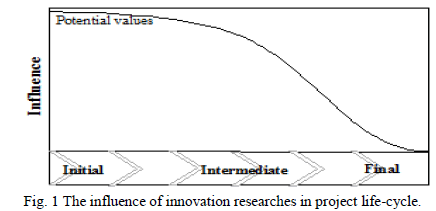 |
| A. Tools of TRIZ i. Contradiction Matrix Matrix of 39-improving parameters and 39-worsening parameters (39 X 39 matrix) with each cell entry giving the most often used (up to 4) inventive principles. This matrix isknown as the "Contradiction Matrix" and remains to be the simplest and the most straightforward of TRIZ tools. 39 features: 1) Weight of moving object 2) Weight of stationary object 3) Lengthof moving object 4) Length of stationary object 5) Area of moving object 6) Area of stationary object 7) Volume of moving object 8) Volume of stationary objects 9) Speed 10) Force 11) Stress or pressure 12) Shape 13) Stability of the object's composition 14) Strength 15) Duration of action by a moving object 16) Duration of action by a stationary object 17) Temperature 18) Illumination intensity 19) Use of energy by moving object 20) Use of energy by stationary object 21) Power 22) Loss of Energy 23) Loss of substance 24) Loss of Information 25) Loss of Time 26) Quantity of substance/the matter 27) Reliability 28) Measurement accuracy 29) Manufacturing precision 30) External harm affects the object 31) Objectgenerated harmful factors 32) Ease of manufacture 33) Ease of operation 34) Ease of repair 35) Adaptability or versatility 36) Device complexity 37) Difficulty of detecting and measuring 38) Extent of automation 39) Productivity. 40 Principles:1) Segmentation 2) Taking out 3) Local quality 4) Asymmetry 5) Merging 6) Universality 7) "Nested doll" 8) Anti-weight 9) Preliminary anti-action 10) Preliminary action 11) Beforehand cushioning 12) Equipotentiality 13) The other way round 14) Spheroidality–Curvature 15) Dynamics 16) Partial or excessive actions 17) Another dimension 18) Mechanical vibration 19) Periodic action 20) Continuity of useful action 21) Skipping 22) "Blessing in disguise" or "Turn Lemons into Lemonade" 23) Feedback 24) 'Intermediary' 25) Self-service 26) Copying 27) Cheap short living objects 28) Mechanics substitution 29) Pneumatics and hydraulics 30) Flexible shells and thin films 31) Porous materials 32) Color changes 33) Homogeneity 34) Discarding and recovering 35) Parameter changes 36) Phase transitions 37) Thermal expansion 38) Strong oxidants 39) Inert atmosphere 40) Composite materials. ii. Technical Systems Anything that executes a task is a technical system. Illustrations of technical systems comprise cars, pens, and books and knifes. Any technical system can consist of one or more subsystems. A car is self-possessed of the subsystems engine, steering mechanism, brakes and so on. Each of these is also a technical system unto itself (with its own series of subsystems) — and each performs its own function. The grading of technical systems spans from the least intricate, with only two elements, to the most intricate with many interrelating elements [4]. iii. Levels of Innovation Exploration of a large number of patents discloses that not every invention is equivalent in its inventive assessment. Altshuller projected five levels of innovation: Level #1is simple enhancement of a technical system. They entail knowledge obtainable inside an industry pertinent to that system. Level #2inventions consist of the tenacity of a technical inconsistency. They need knowledge from diverse zones within an industry applicable to the system. Level #3is an invention covering a purpose of a physical flaw. It necessitates knowledge from additional industries. Levels #2 & #3 resolve paradoxes, and consequently are pioneering by definition. Level #4is development of a new technology. It is industrialized by consuming breakthrough solutions that involves knowledge from altered turfs of science. This fourth level also rallies upon a technical system, but deprived of solving a prevailing technical problem. As an alternative, it mends the function by swapping the original technology with a new technology. For instance a mechanical system is swapped with a chemical system to accomplish the task. Level #5 involves the unearthing of new phenomena. The new marvel is exposed that permits pushing the standing technology to an advanced level. iv. Ideality The objective of any technical system is to deliver some function. Orthodox engineering thought states: âÃâ¬Ãâ¢It is required to deliver such and such a function. Therefore, we must build a mechanism or device to deliver this function.âÃâ¬Ãâ TRIZ philosophy: âÃâ¬Ãâ¢It is required to deliver such and such a function without introducing a new mechanism or device into the system.âÃâ¬Ãâ The Law of Idealitystates that any technical system, throughout its lifetime, tends to become more reliable,simple, effective — more ideal. Every time we improve a technical system, we nudge that system closer to Ideality. It costs less, requires less space, wastes less energy, etc. Ideality always reflects the maximum utilization of existing resources, both internal and external to the system. v. Problem Solving Method The arrows signify alteration from one formulation of the problem or solution to another. This four-step problem solving method powers the manipulator to overcome intrinsic psychosomatic prejudice that is characteristically the basis of psychological ideation techniques. |
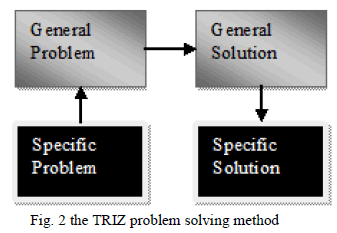 |
| The "General TRIZ Solutions" have been established over the progression of the 60 years of TRIZ study, and have been systematized in numerous different conducts. Some of these are logical methods such as: ïÃâ÷ The Ideal Final Result and Ideality, ïÃâ÷ Functional Modeling, Analysis and Trimming and ïÃâ÷ Locating the Zones of Conflict. (This is more familiar to Six Sigma problem solvers as "Root Cause Analysis.") Some are more prescriptive such as: ïÃâ÷ The 40 Inventive Principles of Problem Solving, ïÃâ÷ The Separation Principles, ïÃâ÷ Laws of Technical Evolution and Technology Forecasting and ïÃâ÷ 76 Standard Solutions. vi. Contradictions An important notion of TRIZ is that inconsistencies should be removed. TRIZ distinguishes two groups of inconsistencies: ïÃâ÷ Technical inconsistencies are the classical engineering "trade-offs." The anticipated state can't be reached because something else in the system averts it. In other words, when something gets improved, something else gets inferior. Classicalexamples include: ïÃâ÷ The product gets stronger (good), but the weight increases (bad). ïÃâ÷ The bandwidth for a communication system increases(good), but requires more power (bad). ïÃâ÷ Facility is personalized to each customer (good), but the facility provision system gets thorny (bad). ïÃâ÷ Working out is widespread (good), but keeps employees missing from their projects (bad). ïÃâ÷ Physical flaws, also called "inherent" contradictions, are situations in which one object or system has contradictory, conflicting chucks. Everyday examples abound: ïÃâ÷ Surveillance aircraft should fly fast (to get to the destination), but should fly slowly to collect data directly over the target for long time periods. ïÃâ÷ Software should be complex (to have many features), but should be simple (to be easy to learn). ïÃâ÷ Coffee should be hot for enjoyable drinking, but cold to prevent burning the customer ïÃâ÷ Training should take a long time (to be thorough), but not take any time. vii. Standards Standards are structured rules for the synthesis and reconstruction of technical systems. Once understood and with some experience in their implementation, Standards can help combat many complex problems that regularly occur throughout industry with some common constraints. Standards provide two functions: 1. Standards help to improve an existing system or synthesize a new one. 2. Standards are the most effective method for providing a graphical model of a problem. This is called Substance- Field (or Su-Field) modeling. The actual contradiction — occurs. In this area, two substances (elements) and a field (energy) must be present. Analysis of the Su-Field model helps determine changes necessary within the technical system in order to improve it. |
II. AIMS AND OBJECTIVES |
| The aims and objectives of this study are listed as follows: ïÃâ÷ To introduce present TRIZ ïÃâ÷ To submit applications in the production industries in India. |
III. SCOPE |
| Indian industries have been primarily borrowing technologies from West and Japan. However, there are three main difficulties, TRIZ can help, in all the three cases, with quick results using fewer resources, to maintain a competitive edge and hold the market share. 1. Next generation product and/or New customer requirements ïÃâç TRIZ tool - Trends of Technical Evolution 2. Some products need to be modified to suit a. availability of new raw materials ïÃâç TRIZ tool - Ideal Final Result and Resources b. new processing equipment ïÃâç TRIZ tool - Functional Analysis / Trimming Chronic engineering problems need to be solved (Chronic implies that all known methods have been tried) ïÃâ÷ TRIZ tool - Technical or Physical Contradictions elimination ïÃâ÷ TRIZ tool - Substance-Field Analysis and system transformations.The algorithm automatically generates mask image without user interaction that contains only text regions to be in painted. |
IV. LITERATURE REVIEW |
| A. Production patents in India According to the database of Intellectual Property Office of India, the patents are classified into categories of goods and services as per the Fourth schedule to Trade marks rules, 2002. [4] Class 1: Chemical used in industry, science, photography, agriculture, horticulture and forestry; unprocessed artificial resins, unprocessed plastics; manures; fire extinguishing compositions; tempering and soldering preparations; chemical substances for preserving foodstuffs; tanning substances; adhesive used in industry Class 2: Paints, varnishes, lacquers; preservatives against rust and against deterioration of wood; colorants; mordents; raw natural resins; metals in foil and powder form for painters; decorators; printers and artists Class 3: Bleaching preparations and other substances for laundry use; cleaning; polishing; scouring and abrasive preparations; soaps; perfumery, essential oils, cosmetics, hair lotions, dentifrices. Class 4: Industrial oils and greases; lubricants; dust absorbing, wetting and binding compositions; fuels (including motor spirit) and illuminants; candles, wicks Class 5: Pharmaceutical, veterinary and sanitary preparations; dietetic substances adapted for medical use, food for babies; plasters, materials for dressings; materials for stopping teeth, dental wax; disinfectants; preparation for destroying vermin; fungicides, herbicides Class 6:Common metals and their alloys; metal building materials; transportable buildings of metal; materials of metal for railway tracks; non-electric cables and wires of common metal; ironmongery, small items of metal hardware; pipes and tubes of metal; safes; goods of common metal not included in other classes; ores Class 7: Machines and machine tools; motors and engines (except for land vehicles); machine coupling and transmission components (except for land vehicles); agricultural implements other than hand-operated; incubators for eggs Class 8: Hand tools and implements (hand-operated); cutlery; side arms; razors Class 9:Scientific, nautical, surveying, electric, photographic, cinematographic, optical, weighing, measuring, signaling, checking (supervision), lifesaving and teaching apparatus and instruments; apparatus for recording, transmission or reproduction of sound or images; magnetic data carriers, recording discs; automatic vending machines and mechanisms for coin-operated apparatus; cash registers, calculating machines, data processing equipment and computers; fire extinguishing apparatus Class 10: Surgical, medical, dental and veterinary apparatus and instruments, artificial limbs, eyes and teeth; orthopedic articles; suture materials Class 11: Apparatus for lighting, heating, steam generating, cooking, refrigerating, drying ventilating, water supply and sanitary purposes Class 12: Vehicles; apparatus for locomotion by land, air or water Class 13: Firearms; ammunition and projectiles; explosives; fire works Class 14: Precious metals and their alloys and goods in precious metals or coated therewith, not included in other classes; jewelry, precious stones; hierological and other chronometric instruments Class 15: Musical instruments Class 16: Paper, cardboard and goods made from these materials, not included in other classes; printed matter; bookbinding material; photographs; stationery; adhesives for stationery or household purposes; artists' materials; paint brushes; typewriters and office requisites (except furniture); instructional and teaching material (except apparatus); plastic materials for packaging (not included in other classes); playing cards; printers' type; printing blocks Class 17: Rubber, gutta-percha, gum, asbestos, mica and goods made from these materials and not included in other classes; plastics in extruded form for use in manufacture; packing, stopping and insulating materials; flexible pipes, not of metal Class 18: Leather and imitations of leather, and goods made of these materials and not included in other classes; animal skins, hides, trunks and travelling bags; umbrellas, parasols and walking sticks; whips, harness and saddler Class 19: Building materials, (non-metallic), non-metallic rigid pipes for building; asphalt, pitch and bitumen; nonmetallic transportable buildings; monuments, not of metal. Class 20: Furniture, mirrors, picture frames; goods (not included in other classes) of wood, cork, reed, cane, wicker, horn, bone, ivory, whalebone, shell, amber, mother- of-pearl, meerschaum and substitutes for all these materials, or of plastics Class 21: Household or kitchen utensils and containers(not of precious metal or coated therewith); combs and sponges; brushes(except paints brushes); brush making materials; articles for cleaning purposes; steel wool; unworked or semiworked glass (except glass used in building); glassware, porcelain and earthenware not included in other classes Class 22: Ropes, string, nets, tents, awnings, tarpaulins, sails, sacks and bags (not included in other classes) padding and stuffing materials (except of rubber or plastics); raw fibrous textile materials Class 23: Yarns and threads, for textile use Class 24: Textiles and textile goods, not included in other classes; bed and table covers. Class 25: Clothing, footwear, headgear Class 26: Lace and embroidery, ribbons and braid; buttons, hooks and eyes, pins and needles; artificial flowers Class 27: Carpets, rugs, mats and matting, linoleum and other materials for covering existing floors; wall hangings (non-textile) Class 28: Games and playthings, gymnastic and sporting articles not included in other classes; decorations for Christmas trees Class 29: Meat, fish, poultry and game; meat extracts; preserved, dried and cooked fruits and vegetables; jellies, jams, fruit sauces; eggs, milk and milk products; edible oils and fats Class 30: Coffee, tea, cocoa, sugar, rice, tapioca, sago, artificial coffee; flour and preparations made from cereals, bread, pastry and confectionery, ices; honey, treacle; yeast, baking powder; salt, mustard; vinegar, sauces, (condiments); spices; ice Class 31: Agricultural, horticultural and forestry products and grains not included in other classes; live animals; fresh fruits and vegetables; seeds, natural plants and flowers; foodstuffs for animals, malt Class 32: Beers, mineral and aerated waters, and other non-alcoholic drinks; fruit drinks and fruit juices; syrups and other preparations for making beverages Class 33: Alcoholic beverages (except beers) Class 34: Tobacco, smokers' articles, matches Services Class 35: Advertising, business management, business administration, office functions. Class 36: Insurance, financial affairs; monetary affairs; real estate affairs. Class 37: Building construction, repair, installation services. Class 38: Telecommunications. Class 39: Transport; packaging and storage of goods; travel arrangement. Class 40: Treatment of materials. Class 41: Education; providing of training; entertainment; sporting and cultural activities. Class 42: Scientific and technological services and research and design relating thereto; industrial analysis and research services; design and development of computer hardware and software. Class 43: Services for providing food and drink; temporary accommodation. Class 44: Medical services, veterinary services, hygienic and beauty care for human beings or animals; agriculture, horticulture and forestry services. Class 45: Legal services; security services for the protection of property and individuals; personal and social services rendered by others to meet the needs of individuals As for the production industry, most creative designs are usually taken as alternatives to cut off unnecessary costs or to increase customer‘s satisfaction, which is the purpose of âÃâ¬Ãâ¢Value Engineering (VE).âÃâ¬Ãâ However some of these innovative ideas are discovered by means of âÃâ¬Ãâ¢Brain-stormingâÃâ¬Ãâ or unpredictable inspirations, while the others are developed via extended academic analysis. In order to systematize this innovation process and to enhance its effectiveness and efficiency, TRIZ, known as a systematic innovation tool, will be applied in this study |
B. History of TRIZ |
| TRIZ, the Theory of Inventive Problem Solving (TIPS), was developed by GenrichAltshuller. During the late 1940‘s he worked in the patent department of the soviet navy to assist inventors in filling patents. After analyzing and deducing more than 200000 worldwide patents, he formed the theoretical basis of TRIZ in 1946 and laid the groundwork for the problem-solving tools that would later be developed [4, 6, 7]. According to some references, the history of TRIZ can be deduced in figure 3 [5, 7, 8]. |
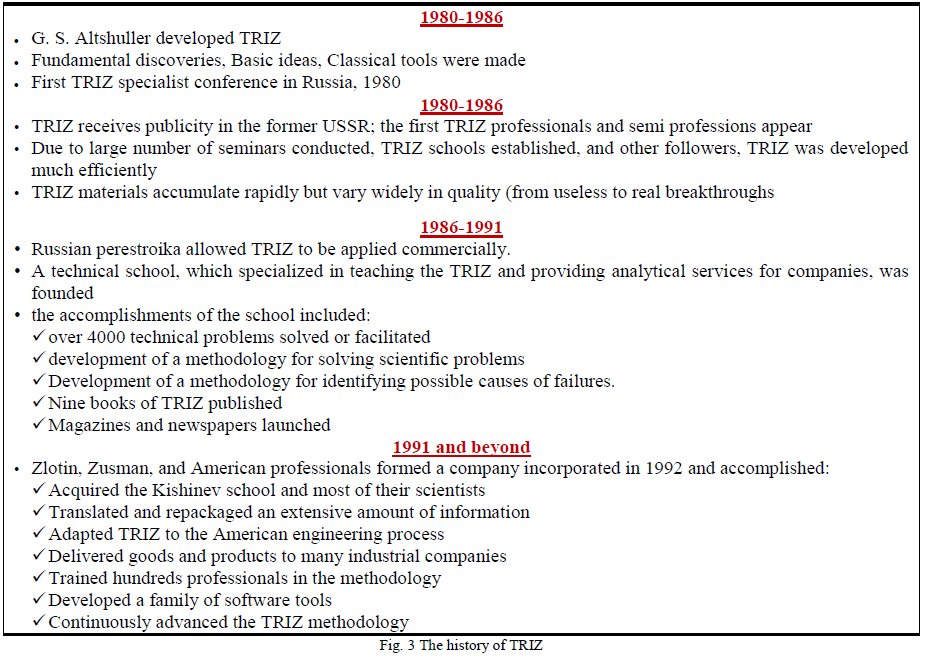 |
C. The Theory of TRIZ |
| Almost all the traditional process of inventions depended upon professional and senior managers/engineers of specific knowledge area to seek specific solution by means of âÃâ¬Ãâ¢Brainstorming.âÃâ¬Ãâ Alike, the famous inventor, Thomas Alva Edison, takes the same manner and also with his abundant inspiration to invent. This procedure has been criticized not only for its limited reasoning, lack of systematic thinking, but also for its effectiveness and efficiency. Due to untraceable spontaneous inspiration, managers/engineers usually delay the best time to solve problems and to fulfill the requirements. In comparison with traditional process of solving problems, this theory âÃâ¬Ãâ¢TRIZâÃâ¬Ãâ transforms specific problems into generic ones (general type of TRIZ), seeks for generic solutions (by ways of TRIZ), and finally infers the specific solution from generic suggestions. The following is the structure diagram of TRIZ, illustrated afterwards. [9, 10, 11, 12, 13, 14, 15] |
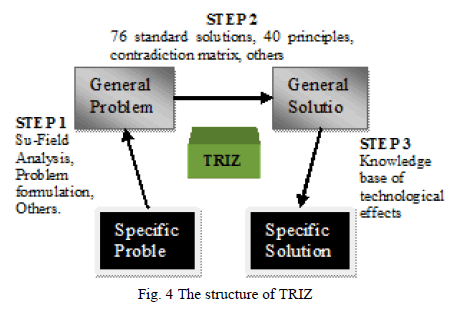 |
| Step 1: Specific problem → generic problem Analysing and defining problems are the first step of the innovation process. There will be nothing more helpful for the following steps than understanding requirements of problems and transforming specific problems into generic ones. Tools such as âÃâ¬Ãâ¢Substance-Field AnalysisâÃâ¬Ãâ (Su-field Analysis) and âÃâ¬Ãâ¢Problem FormulationâÃâ¬Ãâ are often used in the transformation and could let managers/engineers analyse specific problems clearly and systematically in order to clear up inter-relationship of specific problems. Substance-Field Analysis (Su-field Analysis) is an analytical tool for modelling problems related to existing technological systems. Each purpose of the system is to perform some functions; likewise, the desired function is the output from an object or substance (S1) caused by another object (S2) with the help of some means (types of energy, F), which can be expressed as triangular diagrams. Substances are objects that can be single items or complex systems of any level of complexity, such as materials, tools components, human beings, systems environments, etc. And the means of accomplishing action is called a field that can be mechanical, thermal, chemical, electrical, magnetic, gravitational, etc. [6, 12, 16, 17] The method âÃâ¬Ãâ¢Problem FormulationâÃâ¬Ãâ gives an in-depth definition to problems through âÃâ¬Ãâ¢Useful Functions (UFs)âÃâ¬Ãâ and âÃâ¬Ãâ¢Harmful Functions (HFs).âÃâ¬Ãâ There are three kinds of inter-relations between UFs and HFs illustrated in Table 1. |
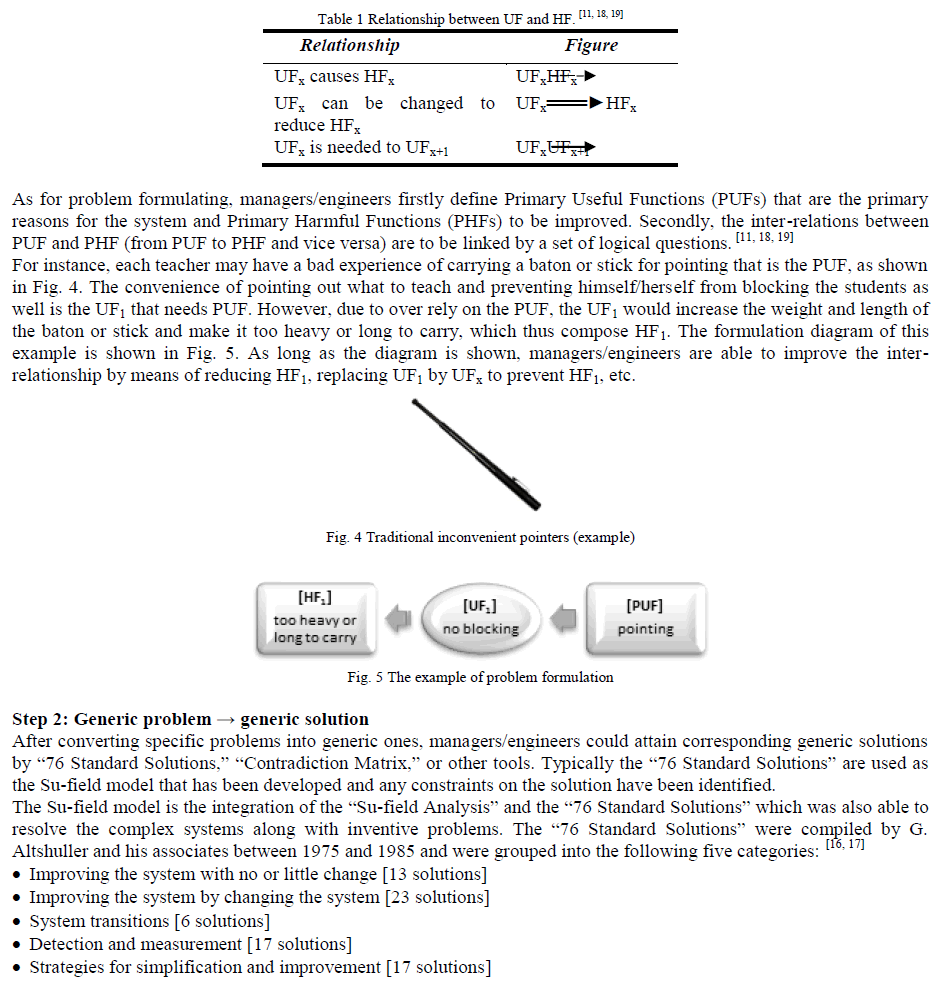 |
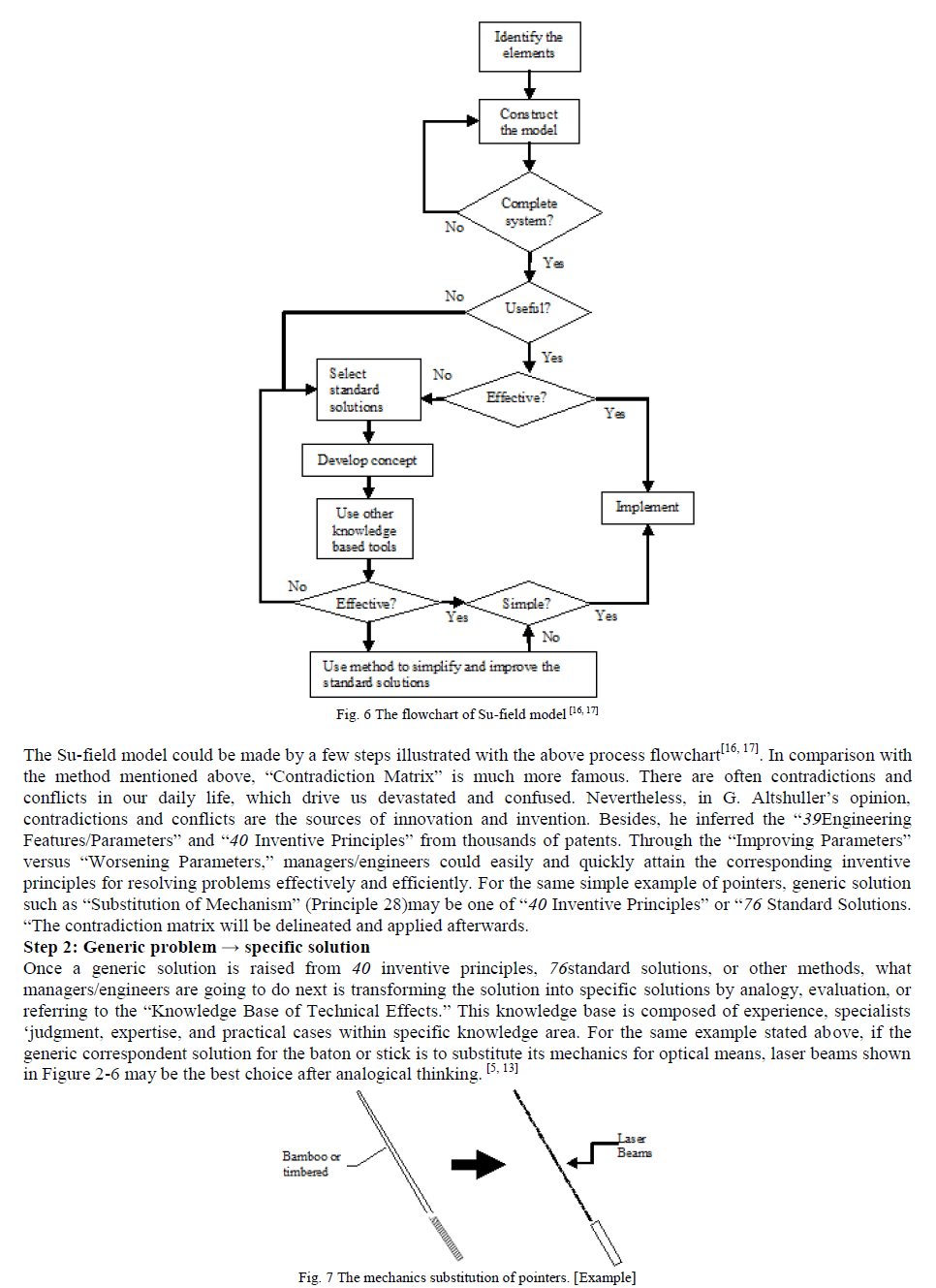 |
| In addition, âÃâ¬Ãâ¢Knowledge Base of Technical EffectsâÃâ¬Ãâ could be developed as a specific âÃâ¬Ãâ¢Decision Support SystemâÃâ¬Ãâ or âÃâ¬Ãâ¢Expert System âÃâ¬Ãâ¢by means of combining with computer programs or software‘s. 40 Inventive Principles: 40 Inventive Principles were deduced by G. Altshuller from lots of worldwide patents. These principles that are generic suggestions, included in âÃâ¬Ãâ¢Contradiction Matrix,âÃâ¬Ãâ can be taken to solve most technical problems efficiently and effectively. Processor Yuan-Nan Chu of National Taiwan University composed six categories of the 40 principles afterward. [20, 21, 22, 23] ïÃâ÷ Transition related to space: principle no. 1, 3, 4, 7, 14 and 17 ïÃâ÷ Transition related to time: principle no. 9- 11, 15, 19, 20, and 21 ïÃâ÷ Transition related to subject: principle no. 2, 5, 6, 13, 22- 28, and 34 ïÃâ÷ Transition related to Acting Force: principle no. 8, 12, 16, 18, and 29 ïÃâ÷ Transition related to Material, Phase, or Shape: principle no. 30- 33, 35, 36, 37, and 40 ïÃâ÷ Transition related to Environment: principle no. 38 and 39 Contradiction Matrix: In accordance with the online website of Oxford Advanced Learner‘s Dictionary, the word âÃâ¬Ãâ¢contradictâÃâ¬Ãâ means âÃâ¬Ãâ¢a lack of agreement between facts, opinions, actions, etc.âÃâ¬Ãâ[24] By analyzing thousands of worldwide patents, G.Altshuller found that most difficult problems in engineering involved physical or technical contradictions, which were solved by making trade-offs traditionally. âÃâ¬Ãâ¢Technical contradictionsâÃâ¬Ãâ result from trying to improve one parameter of technical system and leading to another one to deteriorate, such as power versus energy. However, âÃâ¬Ãâ¢Physical ContradictionsâÃâ¬Ãâ appear when two opposite properties/attributes are required from the same element of a technical system or from the technical system itself.[4, 22, 25, 26] After transforming specific problems into generic ones, managers/engineers should distinguish these two contradictions as illustrated in Figure 8. |
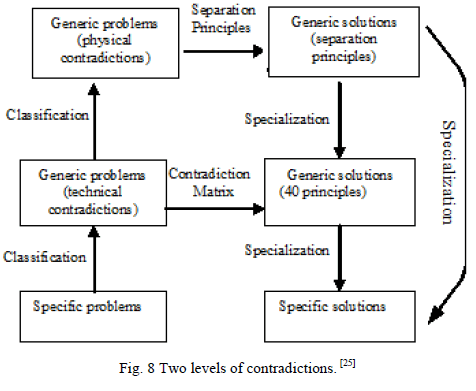 |
| Separation principles, such as (i) separation of opposite requirements in space; (ii) separation of opposite requirements in time; (iii) separation within a whole and its parts, and (iv) separation upon condition, will be good ways for physical contradictions. As for technical contradictions, G. Altshuller pointed out the famous âÃâ¬Ãâ¢Contradiction MatrixâÃâ¬Ãâ of size 39×39, including 39 features/parameters and 40 inventive principles. The columns of the matrix indicateimprovingfeatures/parameters, whiletherowsindicateworseningfeatures/parameters as trying to solve a problem. There are 1263 cells of thematrix that contain a set of possible solutions. These solutions are collected andselected from total 40 invention principles. Managers/engineers could solveproblems by translating system characteristics into these 39 parameters andgetting relative principles suggested.[4, 6, 21, 22, 25, 27, 28] The example of classical âÃâ¬Ãâ¢Contradiction MatrixâÃâ¬Ãâ is illustrated in Table 2. A contradiction occurs when managers/engineers try to improve onecharacteristic, or parameter, of a technical system and cause another characteristic,or parameter, of the system to deteriorate. In the same example mentioned above,the improving parameter and worsening parameter are âÃâ¬Ãâ¢Length of stationaryobjectâÃâ¬Ãâ and âÃâ¬Ãâ¢Weight of stationary object,âÃâ¬Ãâ which correspond to Principle 35,Principle 28, Principle 40, and Principle 29. It is âÃâ¬Ãâ¢Principle 28: MechanicssubstitutionâÃâ¬Ãâ that indirectly creates âÃâ¬Ãâ¢laser pointer pensâÃâ¬Ãâ. Before this invention,teachers always have to carry one baton or stick for pointing. They hope theirbaton or stick to be longer, which is the improving feature. However, the longer ofthe pointer they need, the more weight the baton or stick will be which leads to aninevitable contradiction. Therefore, the mechanics of a baton or stick is substitutedfor optical instrument. This inventive suggestion makes the pointer moreconvenient and much easier to carry as well. [6] |
 |
| It is worth noticing that there is one blank/empty cell of Table 2, the samewith others of âÃâ¬Ãâ¢Contradiction MatrixâÃâ¬Ãâ. Obviously, these blank/empty cells indicatethat managers/engineers would have no idea to deal with the correspondingengineering features/parameters. As a result, they will have to add some steps forgeneric solutions introduced at next section and applied in next chapter. |
V. DISCUSSIONS |
| Apparently, TRIZ can help managers/engineers to resolve the design problemby providing them with an explicit direction to get improvement, such as reducingthe time for searching, avoiding wasting resource and enhancing the quality,effectiveness, efficiency, etc. Nevertheless, the powerful and potent theoryâÃâ¬Ãâ¢TRIZâÃâ¬Ãâ is, without exception, similar to any other method that has its owndeficiencies as well. These contentious subjects, discussed at posterior sections,are: ïÃâç Attaining the right corresponding parameters, including improving andworsening features/parameters, and ïÃâç Blank/empty cells of the âÃâ¬Ãâ¢contradiction matrix.âÃâ¬Ãâ[6, 25, 29, 30] A. Attaining the right corresponding features/parameters Firstly, the requirements confirmation and transformation of the specificproblem are the most important action in the first stage of applying TRIZ.Although TRIZ, the extended methodologies, and the various software productscould also be used as problem definition tools, their greatest strengths areresolving contradictions and solving problems defined by other techniques. [26, 30, 31] Secondly, when using the definition tool such as âÃâ¬Ãâ¢Problem FormulationâÃâ¬Ãâ orâÃâ¬Ãâ¢Su-field AnalysisâÃâ¬Ãâ drawn above, the execution process is usually full ofsubjective factors and personal judgments. What the correct generic solutions needindeed are objectively defining problems and transferring requirements intoengineering features/parameters, which is one of the weaknesses of TRIZ. Regarding this point, the methodology âÃâ¬Ãâ¢Quality Function Deployment(QFD)âÃâ¬Ãâ may be the better answer to link the gap between requirements andmanagers/engineers. The classical TRIZ doesn‘t offer an effective and efficientway to clear the key-point in the whole problem. Importing the QFD can improvethis disadvantage of TRIZ by gathering all relevant information about thecustomers‘ wishes through surveys, interviews, tests, benchmarks, etc. Moreover,the scores of the engineering features/parameters created from the âÃâ¬Ãâ¢House ofQualityâÃâ¬Ãâ of QFD can express the importance of each parameter of the problem. [26, 30, 31] In other words, the primary function of QFD is to identify the most importantissues and parameters of the products and to link priorities and target values backto the customer. In Figure 2-8, a sample of QFD and the sequence of constructingthe âÃâ¬Ãâ¢House of Quality (HOQ)âÃâ¬Ãâ of QFD are shown. [26, 30, 31, 32, 33] Simultaneously with distributing the characteristics of the problem intoengineering features/parameters, a perplexity will occur to managers/engineers totell worsening and improving features/parameters apart. As for these straits,typical TRIZ model relies upon managers‘ or engineers‘ subjective judgments,while âÃâ¬Ãâ¢House of Quality (HOQ)âÃâ¬Ãâ of QFD deals with that more effectively. As onthe roof of the HOQ are identified contradictory relationships among theengineering features/parameters, it seems straightforward that these identifiedcontradictory parameters are used to differentiate improving parameters fromworsening ones. The connection between HOQ and the âÃâ¬Ãâ¢Contradiction MatrixâÃâ¬Ãâ is expressed in Figure 10. [30, 34] |
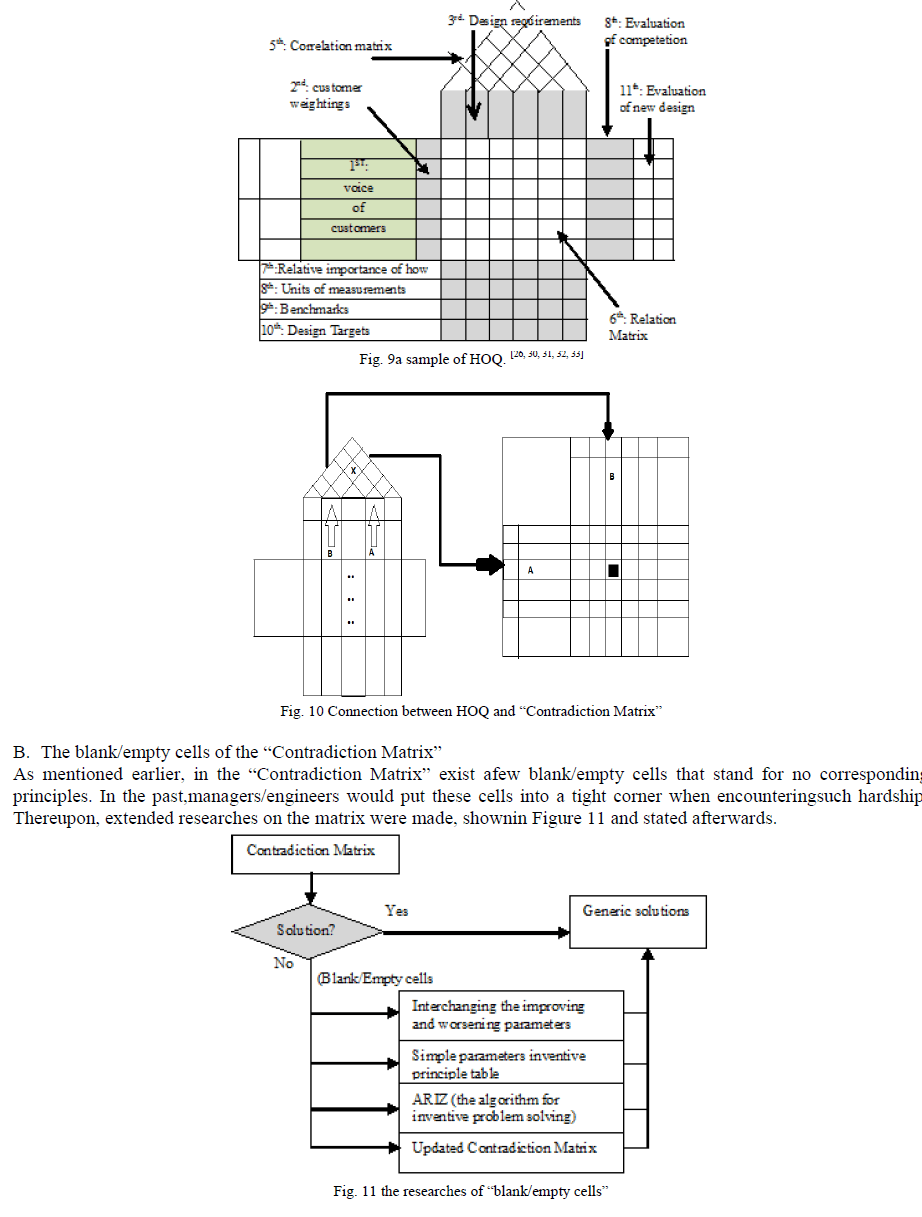 |
| C. ARIZ (The Algorithm for Inventive Problem Solving) ARIZ is composed of a set of systematic steps and various tools forinnovative problems of more complexity. Through its standard process andtools like âÃâ¬Ãâ¢Su-field Model,âÃâ¬Ãâ âÃâ¬Ãâ¢Ideal Final Result,âÃâ¬Ãâ etc., difficulty of theblank/empty cells could be solved step-by-step. [6, 35, 36] D. Interchanging the improving and worsening features/parameters Instead of ARIZ, the corresponding principles obtained frominterchanging the improving and worsening features/parameters could beworth of consideration. [6, 37, 38] E. Single feature/parameter inventive principles table âÃâ¬Ãâ¢Single Feature/Parameter Inventive Principles TableâÃâ¬Ãâ is deduced by statistical methods. According to the G. Altshuller‘s âÃâ¬Ãâ¢Contradiction MatrixâÃâ¬Ãâ of size 39 × 39, the appearance frequency of each principles are statistically counted and assorted as several levels. For example, the appearances of Principle No. 35 are twelve times corresponding to the first âÃâ¬Ãâ¢ImprovingâÃâ¬Ãâ features/parameters (Weight of Moving Object), while nine times are corresponding to the first âÃâ¬Ãâ¢WorseningâÃâ¬Ãâ features/parameters. Therefore, the total appearances of Principle No. 35 corresponding to the first engineering features/parameters are nineteen times, which is assorted as Level A. As a result, managers/engineers could choose suitable inventive principles based on this table.ïüû6, 37, 38ïüý F. Updated contradiction matrix In view of the fact that G. Altshuller‘s classical Contradiction Matrix isevolved during the 50s, 60s, and early 70s, a significant manifestation of theshifts that have taken place in the world of science and technology is that thenumber of things that managers/engineers and scientists have to take intoconsideration when they are designing a solution has increased. As a result,the axes of the matrix are expanded from 39 to 48; also, the puzzle ofblank/empty cells is reinforced and filled. The additional engineeringparameters comprise:[39] ïÃâ÷ Amount of information ïÃâ÷ Function Efficiency ïÃâ÷ Noise ïÃâ÷ Harmful emissions ïÃâ÷ Compatibility/Connect ability ïÃâ÷ Security ïÃâ÷ Safety/Vulnerability ïÃâ÷ Aesthetics ïÃâ÷ Control complexity On the other hand, these new parameters are re-sequenced and classified into six main categories as follows: [39] - Physical related parameters - Performance related parameters - Efficiency related parameters - Illity related parameters (reliability, maintainability, etc.) - Manufacture/Cost reduction related parameters - Measurement |
VI. CONCLUSION |
| From the above discussion, it is no doubt that TRIZ is not only aninfluential but also flexible to all classes of engineering complications of a system. However, it is vital that this theory should be sustained and systematized by other methodologies. Therefore, a systematic innovation model must be developed,in which, more objective tools shall be functional to refine this theory. In correspondence to the purposes of this study, such a systematic innovation model could be useful in the conceptual, design, and construction phases of the construction life for better design or more fiscalsubstitutes. Furthermore, it could be applied to âÃâ¬Ãâ¢Value Engineering (VE)âÃâ¬Ãâ as well. |
References |
|